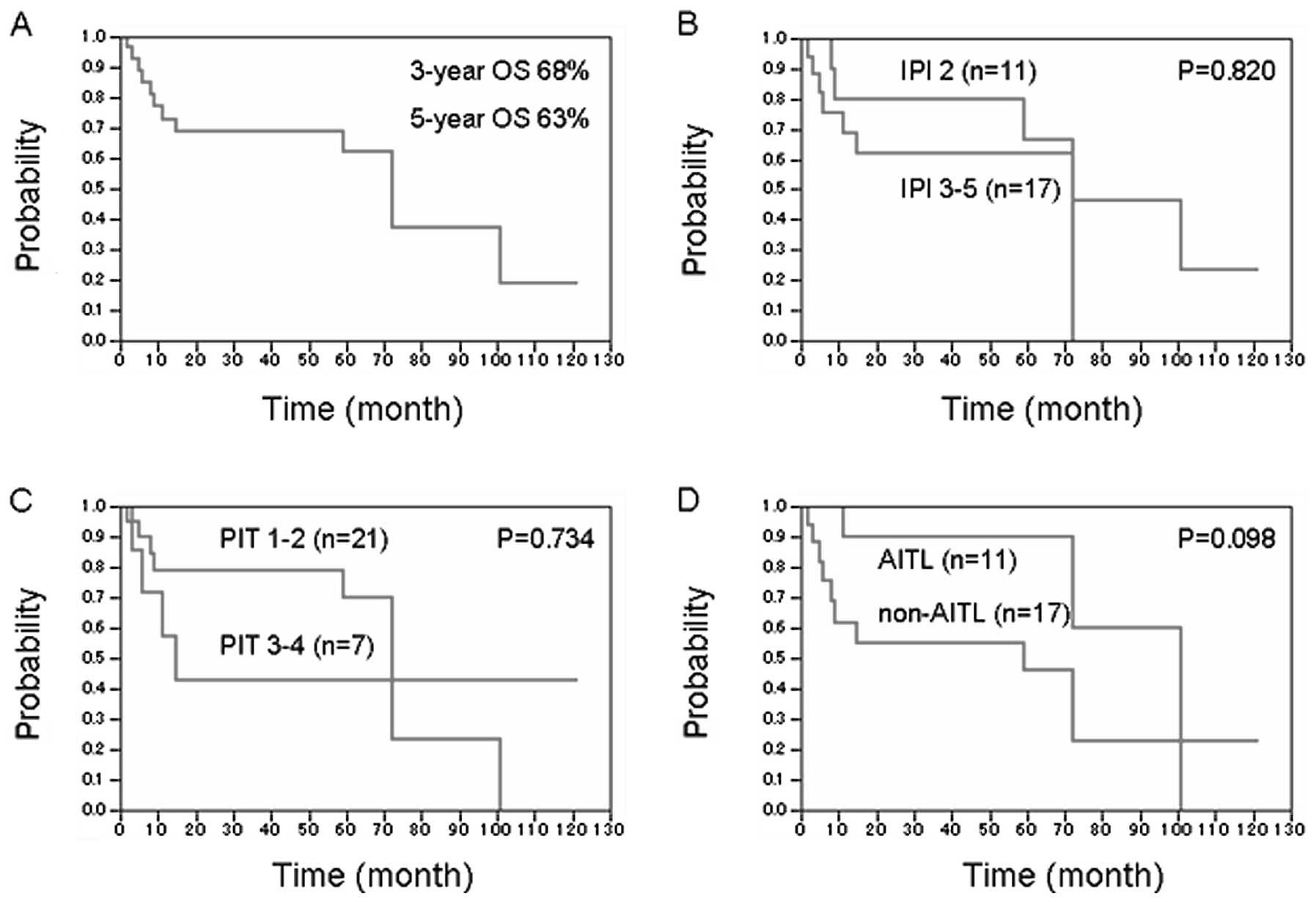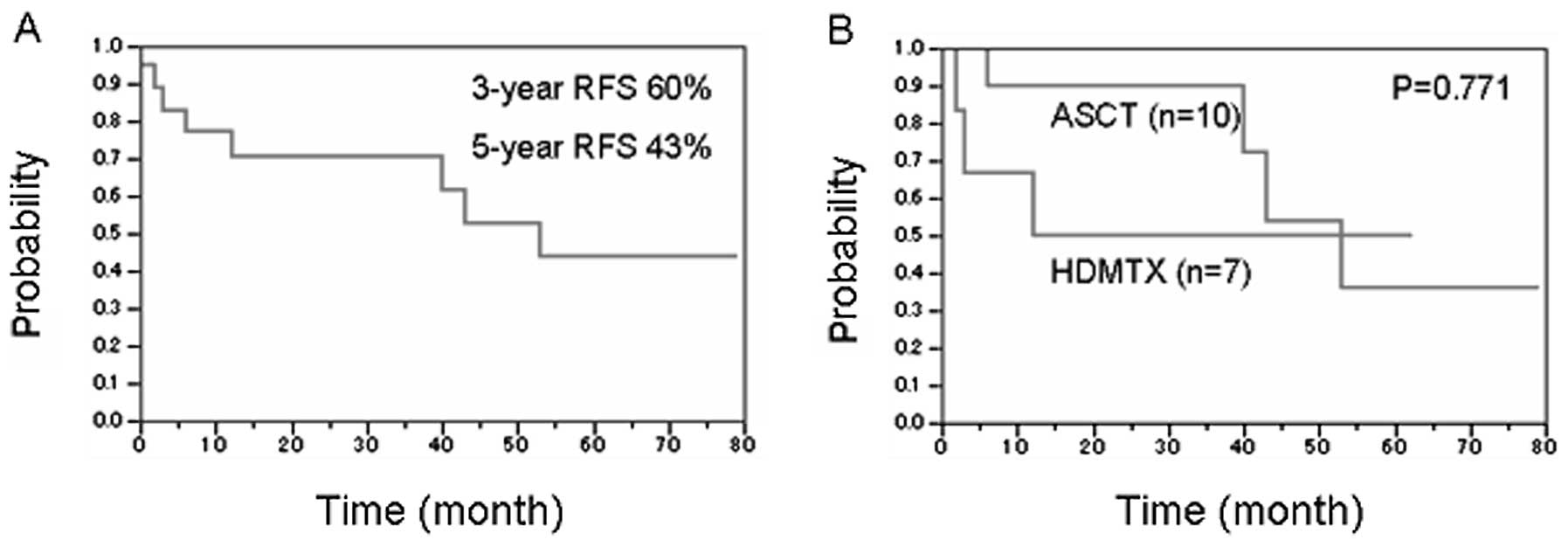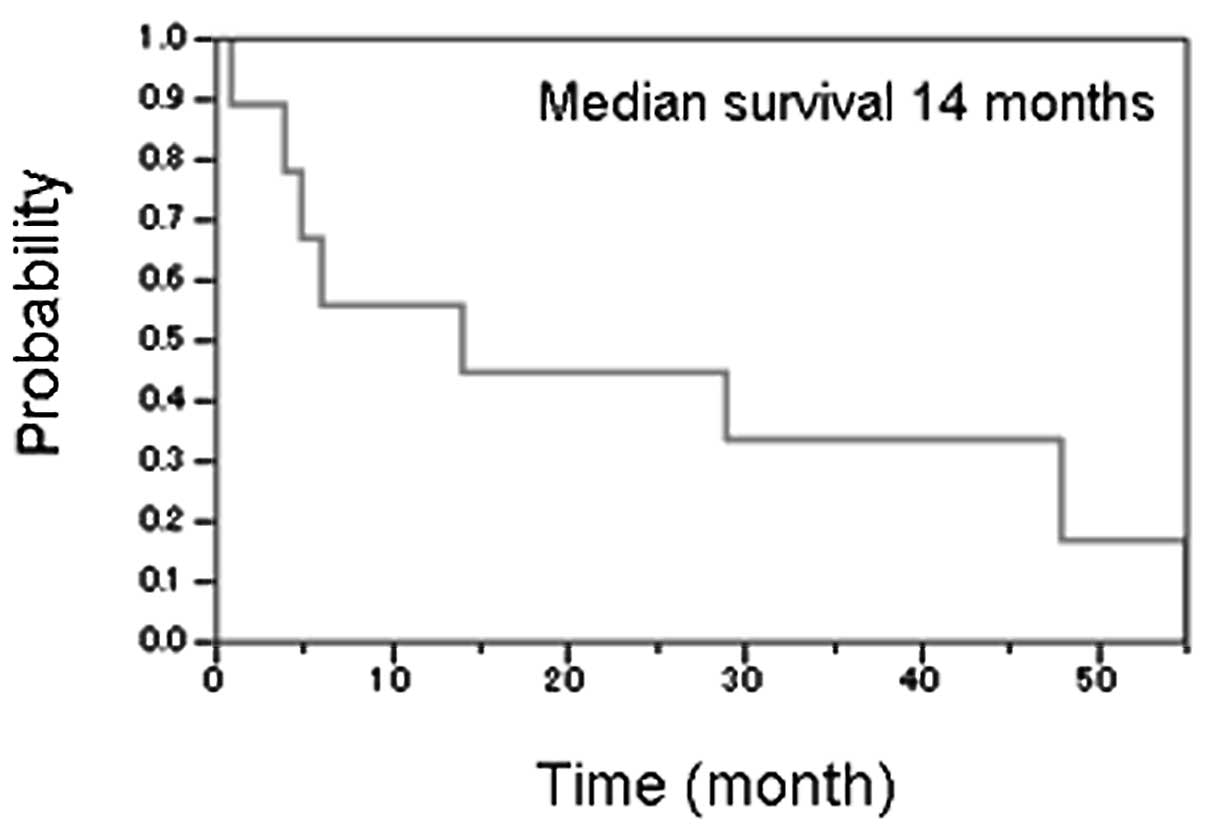|
1
|
Coiffier B, Brousse N, Peuchmaur M, Berger
F, Gisselbrecht C, Bryon PA and Diebold J: Peripheral T-cell
lymphomas have a worse prognosis than B-cell lymphomas: a
prospective study of 361 immunophenotyped patients treated with the
LNH-84 regimen. The GELA (Groupe d’Etude des Lymphomes Agressives).
Ann Oncol. 1:45–50. 1990.
|
|
2
|
Vose J, Armitage J and Weisenburger D:
International T-Cell Lymphoma Project: International peripheral
T-cell and natural killer/T-cell lymphoma study: pathology findings
and clinical outcomes. J Clin Oncol. 26:4124–4130. 2008. View Article : Google Scholar : PubMed/NCBI
|
|
3
|
Sehn LH, Donaldson J, Chhanabhai M,
Fitzgerald C, Gill K, Klasa R, MacPherson N, O’Reilly S, Spinelli
JJ, Sutherland J, Wilson KS, Gascoyne RD and Connors JM:
Introduction of combined CHOP plus rituximab therapy dramatically
improved outcome of diffuse large B-cell lymphoma in British
Columbia. J Clin Oncol. 23:5027–5033. 2005. View Article : Google Scholar : PubMed/NCBI
|
|
4
|
Feugier P, Van Hoof A, Sebban C,
Solal-Celigny P, Bouabdallah R, Ferme C, Christian B, Lepage E,
Tilly H, Morschhauser F, Gaulard P, Salles G, Bosly A, Gisselbrecht
C, Reyes F and Coiffier B: Long-term results of the R-CHOP study in
the treatment of elderly patients with diffuse large B-cell
lymphoma: a study by the Groupe d’Etude des Lymphomes de l’Adulte.
J Clin Oncol. 23:4117–4126. 2005.PubMed/NCBI
|
|
5
|
Gascoyne RD, Aoun P, Wu D, Chhanabhai M,
Skinnider BF, Greiner TC, Morris SW, Connors JM, Vose JM,
Viswanatha DS, Coldman A and Weisenburger DD: Prognostic
significance of anaplastic lymphoma kinase (ALK) protein expression
in adults with anaplastic large cell lymphoma. Blood. 93:3913–3921.
1999.PubMed/NCBI
|
|
6
|
Falini B, Pileri S, Zinzani PL, Carbone A,
Zagonel V, Wolf-Peeters C, Verhoef G, Menestrina F, Todeschini G,
Paulli M, Lazzarino M, Giardini R, Aiello A, Foss HD, Araujo I,
Fizzotti M, Pelicci PG, Flenghi L, Martelli MF and Santucci A:
ALK+ lymphoma: clinico-pathological findings and
outcome. Blood. 93:2697–2706. 1999.PubMed/NCBI
|
|
7
|
Willemze R, Jaffe ES, Burg G, Cerroni L,
Berti E, Swerdlow SH, Ralfkiaer E, Chimenti S, Diaz-Perez JL,
Duncan LM, Grange F, Harris NL, Kempf W, Kerl H, Kurrer M, Knobler
R, Pimpinelli N, Sander C, Santucci M, Sterry W, Vermeer MH,
Wechsler J, Whittaker S and Meijer CJ: WHO-EORTC classification for
cutaneous lymphomas. Blood. 105:3768–3785. 2005. View Article : Google Scholar : PubMed/NCBI
|
|
8
|
Jenni D, Karpova MB, Seifert B, Golling P,
Cozzio A, Kempf W, French LE and Dummer R: Primary cutaneous
lymphoma: two-decade comparison in a population of 263 cases from a
Swiss tertiary referral centre. Br J Dermatol. 164:1071–1077. 2011.
View Article : Google Scholar : PubMed/NCBI
|
|
9
|
Abouyabis AN, Shenoy PJ, Lechowicz MJ and
Flowers CR: Incidence and outcomes of the peripheral T-cell
lymphoma subtypes in the United States. Leuk Lymphoma.
49:2099–2107. 2008. View Article : Google Scholar : PubMed/NCBI
|
|
10
|
Weisenburger DD, Savage KJ, Harris NL,
Gascoyne RD, Jaffe ES, MacLennan KA, Rüdiger T, Pileri S, Nakamura
S, Nathwani B, Campo E, Berger F, Coiffier B, Kim WS, Holte H,
Federico M, Au WY, Tobinai K, Armitage JO and Vose JM:
International Peripheral T-cell Lymphoma Project: Peripheral T-cell
lymphoma, not otherwise specified: a report of 340 cases from the
International Peripheral T-cell Lymphoma Project. Blood.
117:3402–3408. 2011. View Article : Google Scholar : PubMed/NCBI
|
|
11
|
Gisselbrecht C, Gaulard P, Lepage E,
Coiffier B, Brière J, Haioun C, Cazals-Hatem D, Bosly A, Xerri L,
Tilly H, Berger F, Bouhabdallah R and Diebold J: Prognostic
significance of T-cell phenotype in aggressive non-Hodgkin’s
lymphomas. Groupe d’Etudes des Lymphomes de l’Adulte (GELA). Blood.
92:76–82. 1998.
|
|
12
|
Fisher RI, Gaynor ER, Dahlberg S, Oken MM,
Grogan TM, Mize EM, Glick JH, Coltman CA Jr and Miller TP:
Comparison of a standard regimen (CHOP) with three intensive
chemotherapy regimens for advanced non-Hodgkin’s lymphoma. N Engl J
Med. 328:1002–1006. 1993.PubMed/NCBI
|
|
13
|
Kewalramani T, Zelenetz AD,
Teruya-Feldstein J, Hamlin P, Yahalom J, Horwitz S, Nimer SD and
Moskowitz CH: Autologous transplantation for relapsed or primary
refractory peripheral T-cell lymphoma. Br J Haematol. 134:202–207.
2006. View Article : Google Scholar : PubMed/NCBI
|
|
14
|
Song KW, Mollee P, Keating A and Crump M:
Autologous stem cell transplant for relapsed and refractory
peripheral T-cell lymphoma: variable outcome according to
pathological subtype. Br J Haematol. 120:978–985. 2003. View Article : Google Scholar : PubMed/NCBI
|
|
15
|
Hosing C and Champlin RE: Stem-cell
transplantation in T-cell non-Hodgkin’s lymphomas. Ann Oncol.
22:1471–1477. 2011.
|
|
16
|
Casulo C and Horwitz S: Should eligible
patients with T-cell lymphoma receive high-dose therapy and
autologous stem cell transplant in the upfront setting? Curr Oncol
Rep. 12:374–382. 2010. View Article : Google Scholar : PubMed/NCBI
|
|
17
|
Savage KJ: Therapies for peripheral T-cell
lymphomas. Hematology Am Soc Hematol Educ Program. 2011:515–524.
2011. View Article : Google Scholar : PubMed/NCBI
|
|
18
|
Reimer P: Impact of autologous and
allogeneic stem cell transplantation in peripheral T-cell
lymphomas. Adv Hematol. 2010:3206242010. View Article : Google Scholar : PubMed/NCBI
|
|
19
|
Moskowitz AJ and Moskowitz CH:
Controversies in the treatment of lymphoma with autologous
transplantation. Oncologist. 14:921–929. 2009. View Article : Google Scholar : PubMed/NCBI
|
|
20
|
Cheson BD, Horning SJ, Coiffier B, Shipp
MA, Fisher RI, Connors JM, Lister TA, Vose J, Grillo-López A,
Hagenbeek A, Cabanillas F, Klippensten D, Hiddemann W, Castellino
R, Harris NL, Armitage JO, Carter W, Hoppe R and Canellos GP:
Report of an international workshop to standardize response
criteria for non-Hodgkin’s lymphomas. NCI Sponsored International
Working Group. J Clin Oncol. 17:1244–1253. 1999.PubMed/NCBI
|
|
21
|
Ansell SM, Habermann TM, Kurtin PJ, Witzig
TE, Chen MG, Li CY, Inwards DJ and Colgan JP: Predictive capacity
of the International Prognostic Factor Index in patients with
peripheral T-cell lymphoma. J Clin Oncol. 15:2296–2301.
1997.PubMed/NCBI
|
|
22
|
Yang DH, Kim WS, Kim SJ, Bae SH, Kim SH,
Kim IH, Yoon SS, Mun YC, Shin HJ, Chae YS, Kwak JY, Kim H, Kim MK,
Kim JS, Won JH, Lee JJ and Suh CW: Prognostic factors and clinical
outcomes of high-dose chemotherapy followed by autologous stem cell
transplantation in patients with peripheral T cell lymphoma,
unspecified: complete remission at transplantation and the
prognostic index of peripheral T cell lymphoma are the major
factors predictive of outcome. Biol Blood Marrow Transplant.
15:118–125. 2009.
|
|
23
|
Corradini P, Tarella C, Zallio F, Dodero
A, Zanni M, Valagussa P, Gianni AM, Rambaldi A, Barbui T and
Cortelazzo S: Long-term follow-up of patients with peripheral
T-cell lymphomas treated up-front with high-dose chemotherapy
followed by autologous stem cell transplantation. Leukemia.
20:1533–1538. 2006. View Article : Google Scholar : PubMed/NCBI
|
|
24
|
Pfreundschuh M, Zwick C, Zeynalova S,
Dührsen U, Pflüger KH, Vrieling T, Mesters R, Mergenthaler HG,
Einsele H, Bentz M, Lengfelder E, Trümper L, Rübe C, Schmitz N and
Loeffler M: German High-Grade Non-Hodgkin’s Lymphoma Study Group
(DSHNHL): Dose-escalated CHOEP for the treatment of young patients
with aggressive non-Hodgkin’s lymphoma: II. Results of the
randomized high-CHOEP trial of the German High-Grade Non-Hodgkin’s
Lymphoma Study Group (DSHNHL). Ann Oncol. 19:545–552. 2008.
|
|
25
|
Miura K, Takei K, Kobayashi S, Kiso S,
Hirabayashi Y, Hojo A, Kodaira H, Yagi M, Kurita D, Kobayashi Y,
Tanaka T, Iriyama N, Hatta Y, Kura Y, Yamazaki T, Sawada U and
Takeuchi J: An effective salvage treatment using ifosfamide,
etoposide, cytarabine, dexamethasone, and rituximab (R-IVAD) for
patients with relapsed or refractory aggressive B-cell lymphoma.
Int J Hematol. 94:90–96. 2011. View Article : Google Scholar
|
|
26
|
Corradini P, Dodero A, Zallio F,
Caracciolo D, Casini M, Bregni M, Narni F, Patriarca F, Boccadoro
M, Benedetti F, Rambaldi A, Gianni AM and Tarella C:
Graft-versus-lymphoma effect in relapsed peripheral T-cell
non-Hodgkin’s lymphomas after reduced-intensity conditioning
followed by allogeneic transplantation of hematopoietic cells. J
Clin Oncol. 22:2172–2176. 2004.
|
|
27
|
Wulf GG, Hasenkamp J, Jung W, Chapuy B,
Truemper L and Glass B: Reduced intensity conditioning and
allogeneic stem cell transplantation after salvage therapy
integrating alemtuzumab for patients with relapsed peripheral
T-cell non-Hodgkin’s lymphoma. Bone Marrow Transplant. 36:271–273.
2005.PubMed/NCBI
|
|
28
|
Yamazaki T, Sawada U, Kura Y, Ito T,
Kaneita Y, Yasukawa K and Horie T: Dose-intensified CHOP
(double-CHOP) followed by consolidation with high-dose chemotherapy
for high and high-intermediate risk aggressive non-Hodgkin’s
lymphomas. Leuk Lymphoma. 43:2117–2123. 2002.PubMed/NCBI
|
|
29
|
Yamazaki T, Sawada U, Kura Y, Ito T,
Takeuchi J, Hatta Y, Aikawa S, Takei K, Ishizuka H, Saiki M and
Uenogawa K: Treatment of high-risk peripheral T-cell lymphomas
other than anaplastic large-cell lymphoma with a dose-intensified
CHOP regimen followed by high-dose chemotherapy. A single
institution study. Acta Haematol. 116:90–95. 2006. View Article : Google Scholar : PubMed/NCBI
|

















